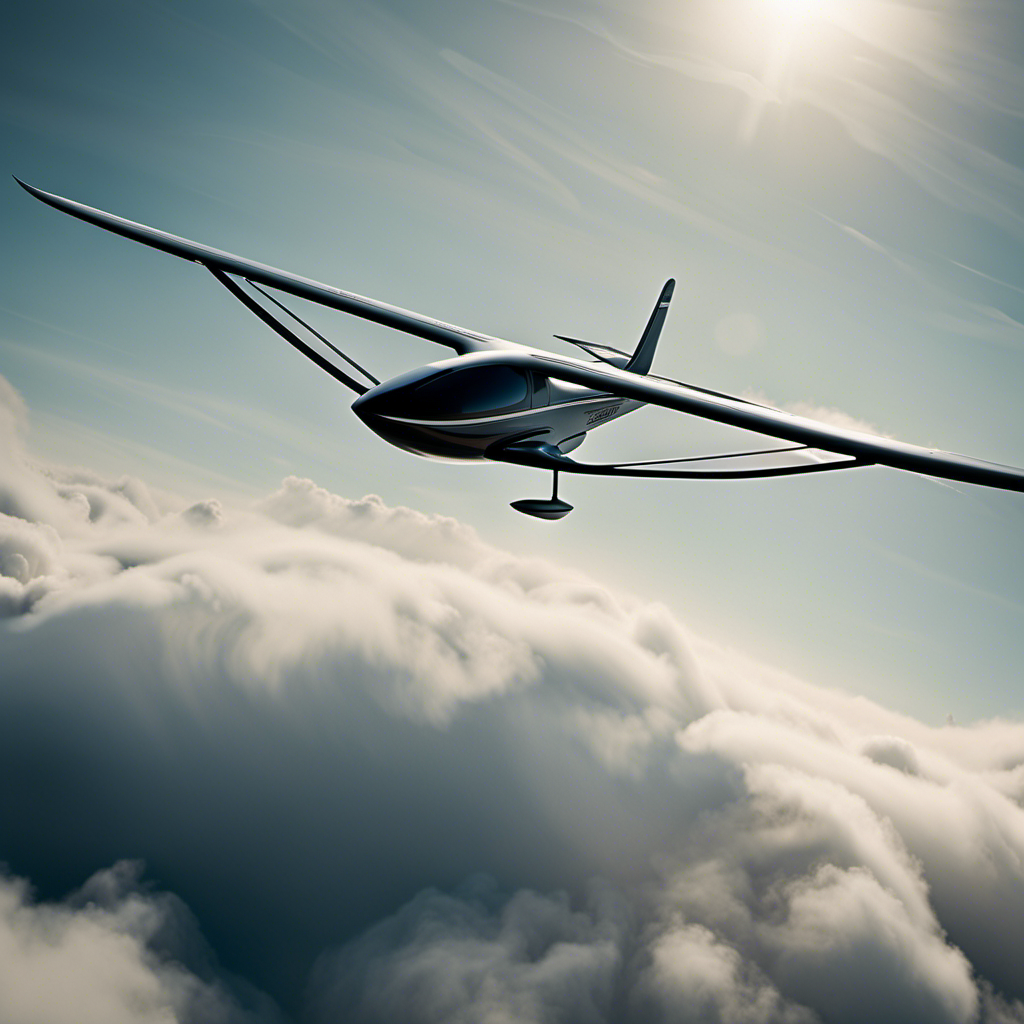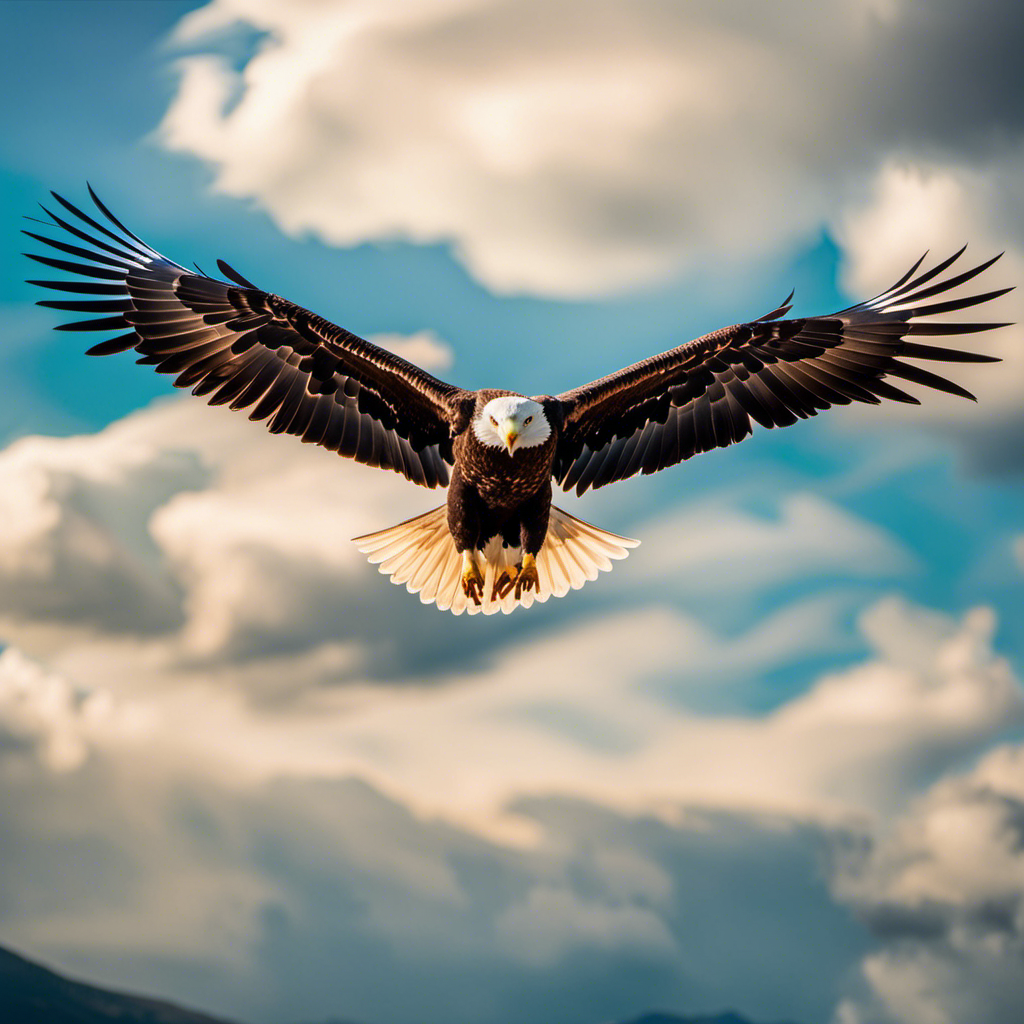I have always been fascinated by the graceful art of gliding. It is incredible to witness how gliders can stay in the air without using an engine, relying solely on natural forces to keep them soaring through the sky.
In this article, we’ll explore the mechanics behind gliding movements and uncover the secrets that allow these aircraft to defy gravity.
From the basics of aerodynamics to the intricacies of glider design, we’ll delve into the world of gliding and discover the wonders that lie within this captivating sport.
Key Takeaways
- Gliding competitions and records showcase the pinnacle of gliding techniques and push the limits of pilots and equipment.
- Gliding clubs and communities provide training and certification to ensure skills and safety, as well as fostering camaraderie through social events and gatherings.
- Proper training and certification are essential for participation in gliding activities and enable pilots to take part in social events and gatherings.
- Gliding as a recreational activity offers the thrill of soaring through the sky, connecting with nature, and opportunities for personal growth and accomplishment.
Brief Overview of Gliding
Gliding occurs when two surfaces slide smoothly past each other, creating minimal friction. In this brief overview of gliding, I will delve into its history and shed light on its key aspects.
Gliding, as a form of human flight, has a rich past dating back to ancient times. From the earliest attempts by the Chinese and Greek inventors to the breakthroughs made by pioneers like Otto Lilienthal and the Wright brothers, gliding has evolved into a widely practiced recreational activity and a competitive sport.
Understanding the basics of gliding is essential to grasp the principles of aerodynamics and how aircraft achieve lift. Transitioning into the next section, let’s explore the fundamentals of aerodynamics and its role in gliding.
The Basics of Aerodynamics
When discussing the basics of aerodynamics, it’s essential to understand the concepts of lift and gravity, as well as drag and thrust.
Lift is the force that opposes gravity and allows an object to stay airborne, while gravity pulls the object downwards.
Drag is the resistance that opposes the forward motion of an object, while thrust is the force that propels the object forward.
Lift and Gravity
As you glide through the air, you’ll feel the opposing forces of lift and gravity working together. Lift analysis is crucial in understanding how gliding movements are achieved. Here’s a closer look at the effects of gravity and how they interact with lift:
-
Lift: Generated by the shape of the wings, lift is the force that counteracts gravity and keeps the glider airborne.
-
Angle of attack: The angle at which the wings meet the oncoming airflow affects the lift generated. A higher angle creates more lift.
-
Wing design: The shape, size, and camber of the wings play a significant role in lift production.
-
Weight distribution: Proper weight distribution is vital for maintaining balance and optimizing lift.
-
Center of gravity: The position of the center of gravity affects the stability and control of the glider.
Understanding these factors allows us to analyze lift and its interaction with gravity in gliding movements.
Now, let’s explore the next aspect: drag and thrust.
Drag and Thrust
The amount of drag experienced by a glider depends on its shape and speed. Drag is the force that opposes the motion of an object through a fluid, in this case, the air. In order to reduce drag, gliders are designed with streamlined shapes that minimize air resistance. Additionally, gliders can adjust their speed to optimize their flight performance. By maintaining a steady speed, gliders can minimize the amount of drag they experience.
Another way to reduce drag is by utilizing efficient propulsion systems. Some gliders are equipped with small engines or propellers that provide additional thrust, allowing them to overcome drag and maintain their forward motion.
Now, let’s explore how gliders stay aloft and maintain their altitude without the aid of an engine.
How Gliders Stay Aloft
Gliders stay aloft by using their wings to generate lift. The wings of a glider are specially designed to create the necessary aerodynamic forces to keep the glider in the air. Here are four key factors that contribute to glider performance:
-
Wing design: Glider wings are typically long and slender, with a high aspect ratio. This shape helps maximize lift and minimize drag.
-
Thermals: Gliders can take advantage of thermals, which are pockets of warm air that rise from the ground. By flying in these updrafts, gliders can gain altitude and extend their flight time.
-
Updrafts: Gliders can also utilize updrafts created by wind hitting the side of a hill or mountain. These updrafts can provide a continuous source of lift, allowing gliders to soar for longer periods.
-
Pilot skill: The pilot’s ability to read the weather conditions, find thermals and updrafts, and make precise control inputs plays a crucial role in maximizing glider performance.
Understanding these factors is essential for glider pilots to make the most of their flights. Now, let’s explore the fascinating world of glider design and construction.
Glider Design and Construction
Glider design and construction involves a careful balance between weight and strength. When it comes to materials, gliders are typically made from lightweight yet durable materials such as carbon fiber or fiberglass. These materials are chosen for their high strength-to-weight ratio, allowing the glider to maintain its structural integrity while keeping the overall weight to a minimum.
The wing design of a glider is crucial for its performance. The wings are typically long and slender, with a high aspect ratio. This design helps to reduce drag and increase lift, allowing the glider to stay aloft for longer periods of time. Additionally, the wings may incorporate various features such as winglets or flaps, which further optimize the glider’s aerodynamic performance.
As we delve into the topic of safety measures in gliding, it is important to understand the intricate design and construction of gliders.
Safety Measures in Gliding
To ensure your safety while gliding, it’s important to familiarize yourself with the proper procedures and protocols. Here are four essential safety measures to keep in mind:
-
Learn and understand emergency procedures: Knowing what to do in case of a critical situation is crucial. Familiarize yourself with emergency protocols such as emergency landings, stall recovery, and responding to instrument failures.
-
Stay informed about weather conditions: Weather can greatly impact your gliding experience. Regularly check weather forecasts and be aware of any potential hazards such as high winds, thunderstorms, or foggy conditions. Make informed decisions based on the weather conditions before taking off.
-
Conduct pre-flight inspections: Before every flight, thoroughly inspect the glider for any signs of damage or malfunction. Check the control surfaces, cables, and instruments to ensure everything is functioning properly.
-
Maintain situational awareness: Always be aware of your surroundings while gliding. Keep a lookout for other aircraft, potential obstacles, and changes in weather conditions. Stay focused and attentive throughout the flight.
By following these safety measures, you can enhance your gliding experience while minimizing the risks involved.
Now, let’s explore the role of the pilot in ensuring a successful gliding adventure.
The Role of the Pilot
Make sure you understand your role as a pilot and the responsibilities that come with it. Pilot training is crucial in order to safely navigate through the skies.
As a pilot, you must possess a deep understanding of navigation techniques to ensure accurate and precise flight paths. This involves utilizing instruments such as altimeters, compasses, and GPS systems to determine your position and direction.
Additionally, you must be knowledgeable about weather patterns and how they can affect your flight. It is your responsibility to make informed decisions based on this information, ensuring the safety of yourself and your passengers.
Understanding your role as a pilot and mastering these navigation techniques is paramount to a successful and secure flight. Transitioning into gliding competitions and records, pilots showcase their skills and push the limits of their abilities.
Gliding Competitions and Records
As the pilot plays a crucial role in gliding movements, it is important to understand how their skills are put to the test in gliding competitions and records. These events showcase the pinnacle of gliding techniques and push the limits of both pilot and gliding equipment. Competitors must demonstrate exceptional knowledge of aerodynamics, weather patterns, and navigation to maximize their performance.
Gliding competitions feature various categories, such as distance, speed, and duration, allowing pilots to showcase their expertise in specific areas. Records, on the other hand, focus on surpassing previous achievements and setting new benchmarks in gliding. By constantly pushing boundaries, gliding competitions and records serve as a platform for innovation and advancement in the sport.
Now, let’s delve into the world of gliding clubs and communities, where enthusiasts come together to share their passion and experiences.
Gliding Clubs and Communities
When it comes to gliding clubs and communities, two key points that play a crucial role are training and certification, as well as social events and gatherings.
The process of training and certification ensures that pilots have the necessary skills and knowledge to safely navigate the skies. It also allows for a standardized level of proficiency within the gliding community.
Social events and gatherings, on the other hand, provide an opportunity for pilots to come together and share their experiences, build camaraderie, and learn from one another. These events foster a sense of community and contribute to the overall growth and development of gliding as a sport.
Training and Certification
Gliding movements require proper training and certification to ensure safety. Training techniques used in gliding clubs focus on teaching pilots the necessary skills to operate a glider effectively. These techniques include theoretical knowledge, practical flight training, and simulator sessions.
The licensing process involves passing written exams, demonstrating practical flying skills, and meeting specific requirements set by aviation authorities. This rigorous process ensures that glider pilots possess the necessary knowledge and skills to handle various flight scenarios and navigate safely.
Once certified, glider pilots have the opportunity to participate in social events and gatherings organized by gliding clubs. These events provide an avenue for pilots to connect with fellow enthusiasts, share experiences, and further enhance their skills through interactions and discussions.
Transitioning from training and certification to engaging in social events fosters a sense of community among glider pilots.
Social Events and Gatherings
Participating in social events and gatherings allows glider pilots to connect with fellow enthusiasts and further enhance their skills through interactions and discussions. Socializing in the gliding community is not only a way to make new friends, but also an opportunity to network and learn from experienced pilots. Here are three reasons why social events and gatherings are beneficial for glider pilots:
-
Knowledge Sharing: These events provide a platform for pilots to exchange their experiences, techniques, and tips. Engaging in conversations with other pilots can lead to valuable insights and improve one’s flying abilities.
-
Mentorship Opportunities: Networking with seasoned glider pilots can open doors to mentorship opportunities. Learning from their expertise and guidance can help pilots refine their skills and gain a deeper understanding of the sport.
-
Community Building: Social events foster a sense of community among glider pilots. This camaraderie creates a supportive environment where new pilots can find encouragement and motivation to pursue their gliding journey.
By actively participating in social events and gatherings, glider pilots can develop meaningful connections and gain valuable knowledge to enhance their flying experience.
Transitioning into the subsequent section about ‘gliding as a recreational activity,’ let’s explore the thrill and joy of taking to the skies.
Gliding as a Recreational Activity
Visiting a gliding club can be a great way to experience the thrill of soaring through the sky. Gliding, as a recreational activity, offers numerous benefits for enthusiasts.
Not only does it provide a sense of freedom and adventure, but it also allows individuals to connect with nature and appreciate the beauty of the surroundings from a unique perspective.
Gliding techniques, such as thermaling and ridge soaring, require skill and precision, making it a challenging yet rewarding activity. Mastering these techniques can lead to a sense of accomplishment and personal growth.
Additionally, gliding can provide opportunities for social interaction and camaraderie among fellow gliders.
As we look ahead to the future of gliding, advancements in technology and aerodynamics will continue to enhance the overall experience, making it even more accessible and exciting for enthusiasts.
The Future of Gliding
As I glide through the sky, I can’t help but wonder what the future holds for this exhilarating recreational activity. Gliding has come a long way since its inception, and with advancements in technology, the possibilities for future innovations are endless.
Here are three exciting developments that could shape the future of gliding:
-
Electric-powered gliders: With the increasing focus on sustainability, electric-powered gliders are gaining traction. These gliders have the potential to reduce the environmental impact of gliding by eliminating the need for fossil fuels.
-
Advanced materials: The use of lightweight and durable materials, such as carbon fiber composites, can enhance the performance and safety of gliders. These materials offer improved strength-to-weight ratios, allowing for more efficient and aerodynamic designs.
-
Autonomous gliders: Imagine a glider that can navigate itself, using advanced sensors and algorithms. Autonomous gliders could revolutionize the sport by providing a new level of safety and precision.
As we look ahead, it’s exciting to envision the future of gliding and the positive impact it could have on both the environment and the overall gliding experience.
Frequently Asked Questions
What are the health benefits of gliding?
Gliding movements offer numerous health benefits. They improve physical fitness by enhancing core strength, balance, and flexibility. Additionally, they promote mental relaxation by reducing stress and increasing mindfulness. Overall, gliding is a great way to improve both physical and mental well-being.
How much does it cost to get started in gliding?
Getting started in gliding can be an exhilarating experience, but it might cost you an arm and a leg! Cost factors include membership fees, training expenses, and aircraft rentals. Additionally, you’ll need equipment like a parachute, flight suit, and a radio.
Can gliders be flown in bad weather conditions?
Gliders should not be flown in bad weather conditions due to safety concerns. Flying techniques and safety precautions are crucial in gliding. It is important to prioritize safety and avoid flying in unfavorable weather conditions.
What is the average duration of a glider flight?
The average flight time of a glider depends on various factors. These include weather conditions, thermal activity, and the pilot’s skill level. Flight durations can range from a few minutes to several hours, providing an exhilarating experience in the sky.
Are there any age restrictions for learning to glide?
There are no age restrictions for learning to glide. It’s never too late to take up this thrilling sport. However, it’s important to undergo proper training and meet the physical requirements to ensure a safe and enjoyable experience.
Conclusion
In conclusion, gliding is a remarkable sport that combines the thrill of flight with the art of mastering aerodynamics.
Through a combination of skillful piloting and meticulous design, gliders are able to soar through the skies with grace and precision.
Safety measures and competitions further enhance the gliding experience, creating a vibrant community of enthusiasts.
As we look to the future, advancements in glider technology and a growing interest in recreational flying ensure that this timeless sport will continue to captivate and inspire.
So spread your wings and experience the freedom of gliding for yourself.
With a heart that soars as high as the skies, Aria, affectionately known as “Skylark,” is the driving force behind Soaring Skyways. Her journey into the gliding world began as a young dreamer gazing up at the soaring birds, yearning to experience the weightlessness and freedom they embodied. With years of experience both in the cockpit and behind the scenes, Aria’s commitment to the gliding community is unwavering.










